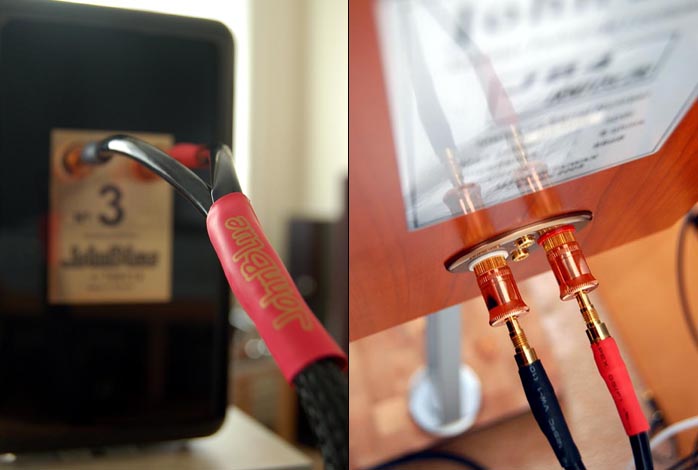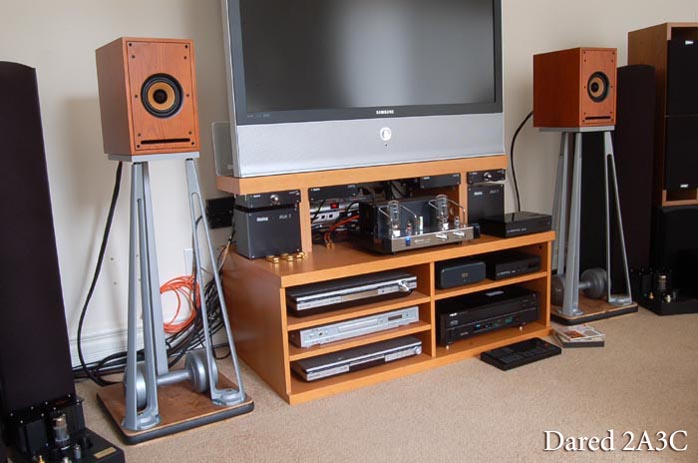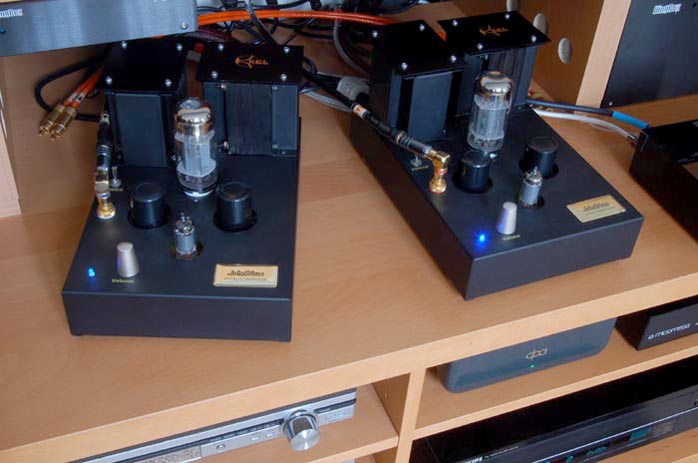|
This review page is supported in part by the sponsors whose ad banners are displayed below
|
|||||||||||||||
 |
|||||||||||||||
Part 3: Speaker Cable 2S JohnBlue's humbly priced entry-level speaker cables 2S (meaning 2 stars) come as a 3m pair insulated with Teflon, wrapped in a PVC jacket and finished with 24K 10μ gold-plated banana plugs. Thin and lightweight you might say. But for $150, the look and finish already bespoke value for money. If it sounded good, why even bother to DIY? |
|||||||||||||||
|
| |||||||||||||||
Tommy reiterated that I had to try these cables on the JB3. He further sent along two of his own compilation demo CDs that contain some standard classical showpieces like Sarasate's Zigeunerweisen, Chinese and Western popular songs of the lyrical mostly female vocal type and Chinese bamboo flute music with percussion. Even before being properly run in, the 2S knocked my jaws loose. The system included the Micromega Microdrive and Variodac and the JohnBlue TL66 amp originally connected to the JB3 via OCOS speaker cables. If I had these cables when I reviewed the JB3, I wouldn't have complained about lack of bass. After a few months of breaking them in with various kit, I brought them back to the TL66 + JB3. It only got better and not just the bass. The entire frequency spectrum that the single drivers were capable of was finally revealed fully. The soundstage was naturally laid out and localization cues were spontaneously uncluttered. All the things one would wish for in single-driver speakers were accounted for with this tiny 3-incher. What were the secret ingredients? |
|||||||||||||||
 |
|||||||||||||||
Tommy responded with a simple diagram of his cable geometry: Discreet asymmetrical legs to minimize cross talk between plus and minus runs; thin silver-plated copper strand for the former, thick 4N copper strand for the latter. So that was the secret? It's no secret at all since a lot of cables, interconnects included, are designed around this very same concept if not constructed exactly in the same way. I didn't have the scientific mind to pry farther into Tommy's trade secret so I left it at that and asked for an extra pair to try them out with bi-amp and bi-wireable speaker scenarios. |
|||||||||||||||
 |
|||||||||||||||
I have to admit that some synergy does exist when the whole system is unanimously JohnBlue Audio Art. After all, the designer used these wires to voice his components and accessories. I have a pair of JB4 speakers in for a 2nd opinion after Frederic's feature review so I let them replace the JB3. On hearing that, the signature sound Tommy was trying to achieve became clear. It's a kind of tubish sound that has an antique amp's old-fashioned timbre. It makes a modern Steinway sound at least fifty years older. It's not exactly slow but well paced. It's not exactly mellower but certainly wooden and bronzed like a matt metallic ringing that weighs down the midrange and clings to the decay trails for that nostalgic ambience as opposed to being bright and brassy or glorious and golden. The good news was that it didn't cloud up resolution. It rather enriched the vocals with more body while keeping the finesse in diction. Maria Callas became even more passionate, Kiri Te Kanawa's nasal murky lower registers more pronounced. |
|||||||||||||||
 |
|||||||||||||||
Which component contributed what percentage to this was hard to gauge. Since this bronze sound was most noticeable with the TL66 + 2S + JB4 combo, less so with the JB3 and even less without the TL66 amps, I presume the amps contributed the most and the speaker cables the least. It should be noted that the bronze tone I heard was one of the amp's voicing goals and should not be confused with the high-frequency ringing that plagues some single-driver speakers. When I took off the OCOS cables, I also removed their impedance stabilizer, a Zobel network that helps control ultrasonic ringing. Without this Zobel network, the JohnBlue 2S kept high frequency ringing at bay. That was comforting. It allowed the proprietary JohnBlue 4" widebander to show off an extended frequency response almost unbelievable for its size. |
|||||||||||||||
 |
|||||||||||||||
For cross examination, I hooked up the Dared 2A3C integrated amp to the JB4. The treble was crystal clear and the midrange soothingly mellow. I had a slightly warmer tone with the low-gauge Dared cables. Bass was less impressive than over the TL66, a predictable conclusion between 2A3 and 6L6 tubes. Soundstage and imaging were infallible with pin-point accuracy. I no longer noticed the bronze timbre and the Steinway sounded modern and uplifting again but vocals now were slightly thin. |
|||||||||||||||
 |
|||||||||||||||
When I asked Tommy whether the 2S cable was specially designed for the JB3, his answer was that "it suits the JB3 best but also works with other speakers". It didn't disappoint me with the JB4 (although I believe a higher-grade JB speaker cable might work even better) and I wanted to try them on non-JB products. I remained with the TL66 and tried bi-wiring the Klipsch Synergy F2 with a double run of JohnBlue S2 cables by adding gold-plated spades to one pair, replacing my favored OCOS. The 2S didn't reinforce the bass line of the Klipsch F2 as it did with the JB3 and JB4. At the same time it didn't weaken it vis-à-vis the OCOS, a good sign. The 2S was not counter-productive in that sense. Were the lower octave chops of the Klipsch F2 so readily deliverable as to be less picky of amps or cables? Call it the easy-going nature of affordable speakers perhaps. The only minor quibble was a slightly veiled treble. Violin pizzicatos for instance were less effervescent and triangles less sparkly - but only marginally so. The bronze overtones must have been subdued a lot. I wasn't really aware of them until I flipped through my notes and reminded myself to double-check. And yes, I could still hear that tonality when looked for it but the warmth and musicality of the Klipsch took over. Changing to a bi-amp scenario with the modified KingRexT20U, I once again replaced my faithful old OCOS cable with the JohnBlue 2S. Whether driving the Klipsch F2 or Loth-X BS1 with their D'Appolito array, the bronze ringing completely vanished to confirm that the TL66 was indeed the major contributor. The major differences between the OCOS and JB 2S cables were resolution and soundstaging. The OCOS had the upper hand with a wider, better layered soundscape and superior instrumental placement. However the JB 2S didn't trail far behind considering the huge price discrepancy and being JohnBlue's most affordable model. To make up for the minor lag, the 2S sweetened the deal with a slightly warmer presentation that furthered the ongoing hallucination of tube sound without tubes. The strongest merit of the JohnBlue 2S is its neutrality so close to the much pricier OCOS. As a budget cable, it has nothing to apologize for. It is a great asset for those who want a speaker cable honest enough to reveal what their wallet and single drivers are capable of. |
|||||||||||||||
|
| |||||||||||||||
 |
|||||||||||||||
|
JohnBlue Audio Art website
|
|||||||||||||||
 |
|||||||||||||||